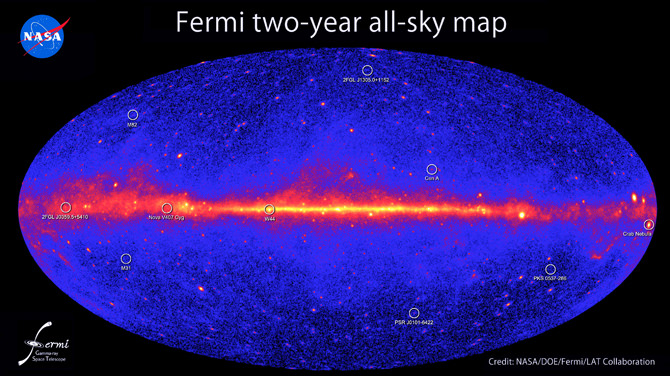[/caption]
When it comes to high-energy sources, no one knows them better than NASA’s Fermi Gamma-ray Space Telescope. Taking a portrait of the entire sky every 240 minutes, the program is continually renewing and updating its sources and once a year the scientists harvest the data. These annual gatherings are then re-worked with new tools to produce an ever-deeper look into the Universe around us.
Fermi is famous for its analysis of steady gamma-ray sources, numerous transient events, the dreaded GRB and even flares from the Sun. Its all-sky map absolutely bristles with the energy that’s out there and earlier this year a second catalog of objects was released to eager public eyes. An astounding 1,873 objects were detected by the satellite’s Large Area Telescope (LAT) and this high energy form of light is turning some heads.
“More than half of these sources are active galaxies, whose massive black holes are responsible for the gamma-ray emissions that the LAT detects,” said Gino Tosti, an astrophysicist at the University of Perugia in Italy and currently a visiting scientist at SLAC National Accelerator Laboratory in Menlo Park, California.
One of the scientists who led the new compilation, Tosti presented a paper on the catalog at a meeting of the American Astronomical Society’s High Energy Astrophysics Division in Newport, R.I. “What is perhaps the most intriguing aspect of our new catalog is the large number of sources not associated with objects detected at any other wavelength,” he noted.
If we were to look at Fermi’s gathering experience as a harvest, we’d see two major components – crops and mystery. Add to that a bushel of pulsars, a basket of supernova remnants and a handful of other things, like galaxies and globular clusters. For Fermi farmers, harvesting new types of gamma-ray-emitting objects that are from “unassociated sources” would account for about 31% of the cash crop. However, the brave little Fermi LAT is producing results from some highly unusual sources. Mystery growth? Think this way… If it’s a light source, then it has a spectrum. When it comes to gamma rays, they’re seen at different energies. “At some energy, the spectra of many objects display what astronomers call a spectral break, that is, a greater-than-expected drop-off in the number of gamma rays seen at increasing energies.” Let’s take a look at two…
Within our galaxy is 2FGL J0359.5+5410. Right now, scientists just don’t understand what it is… only that it’s located in the constellation Camelopardalis. Since it appears about midplane, we’re just assuming it belongs to the Milky Way. From its spectrum, it might be a pulsar – but one without a pulse. Or how about 2FGL J1305.0+1152? It also resides along the midplane and smack dab in the middle of galaxy country – Virgo. Even after two years, Fermi can’t tease out any more details. It doesn’t even have a spectral break!
Pulsar? Blazar? Mystery…
Original Story Source: NASA Fermi News.


I’ve stumbled upon this paper (PDF); it may be the one referred to in the above article:
Challenges from ?-ray Spectra of Blazars at the Two Ends of the Blazar Sequence.
Always nice to see some new mysteries to be solved.
gamma Ray is most interesting and mystical topic
Some of the unassociated Gamma rays peak in the 100-1000GeV range. Some thought is that this is due to the annihilation of neutralinos. This is a prime candidate for dark matter.
LC